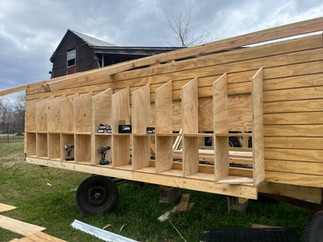We Did Something Crazy...
- Bridget Jones

- Apr 3, 2022
- 3 min read
I have always had a dream of putting a hundred or two chickens in our back field, rotate them through the field for a season, then the following season over-seed the field with alfalfa or timothy grass, then move the chickens to another area on the farm.
This is a no-till farming practice, that uses the chickens constant scratching and pecking to till and rid the field of pests, and their droppings as fertilizer. No-till farming cuts down on erosion, which is really important, especially with our farm being so close to rivers that feed the Chesapeake Bay.
At the end last season, we started to make this dream a reality. We sourced a trailer, built the frame, and then designed a plan to build a HUGE mobile chicken house. The key-points of the trailer build that were important are the two rows of brooder boxes, the steel grating for the floor (for droppings to fall through as the chickens roost at night), and angled roosting bars to maximize the space to roost.
Over the winter, Matt worked on the build and we put in an order for 220 chicks to be delivered the week of March 28th. This gave us a solid dead-line for finishing up this project in time to brood the chicks inside the trailer, which was my plan all along! (Because who wants to brood 220 chicks in their house?!)
Inside of the trailer, I had Matt make what I am calling the "play-pen", Matt used the roosting bars as support for plywood walls, and we laid plywood over the steel grating as the floor of the brooding area. This way I could put down bedding for the chicks without it falling through the grating. We also used heat plates as the source of warmth for the chicks, which mimics a mother hen. These plates also use less electricity than a heat lamp, and in terms of fire safety, they are safer than heat lamps as well.

On Thursday, March 31st I got the call from the post office that our chicks had arrived! I picked them up from the USPS distribution center, and brought them home to the farm. When you receive new baby chicks from the hatchery, they have just made a long journey through the mail, so they are tired, and thirsty! You have to show them where the water is, we call this "baptizing" the chicks. You essentially dip their beak into the water. Imagine baptizing 220 chicks.
Because we are brooding such a large flock of chicks, I did expect some loss. Initially I was thinking a total loss of about 20%. We did lose about 7 total when the chicks arrived in the mail. The first night we lost 12 more, and the following night we lost even more. Total we lost about 75 chicks in the first two days. We experienced about a 30% loss total. In the future, my goal is to get that loss percentage down to 10-20%, and with this being our first time brooding chicks on such a large scale, I am learning a lot!
We aren't totally sure what breeds of female chicks we have, as we ordered an assortment of choice layers from the hatchery. We also ordered 20 roosters total for this flock, they are Rhode Island Reds, Buff Orpingtons, Brown Leghorns, and Barred Rocks.
In terms of the trailer build, what is left to finish up is the doors for the nesting boxes, adding an automatic coop door, and adding a large feeder, and a rain barrel system for water. These will be finished over the next 6 weeks as we brood the chicks inside. Once they are old enough to be outside regularly (at 6 weeks of age), we will utilize electric netting fencing to keep them safe from ground predators, and a greenhouse frame with avian netting to keep them safe from arial predators (until they are fully grown at about 18-20 weeks).

We are looking forward to watching them grow, and carrying on this new adventure for the farm!















Commentaires